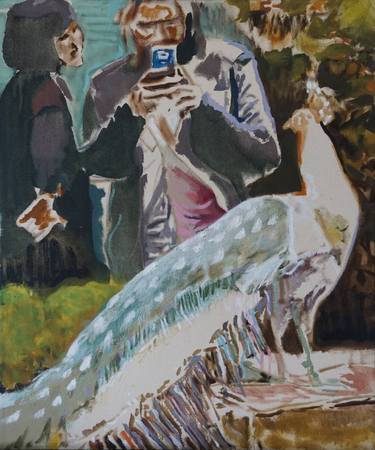Discovering the Depths of Emotion with Figurative Oil Painting Methods
Discovering the Depths of Emotion with Figurative Oil Painting Methods
Blog Article
The Role of Feeling and Expression in Metaphorical Oil Paint: A Thorough Analysis of Subject and Make-up
The interaction of feeling and expression in figurative oil paint serves as an important lens via which one can take a look at the intricate partnership between subject matter and make-up. Artists harness different strategies, from color choice to brushstroke characteristics, to cultivate psychological vibration within their works.
Comprehending Feeling in Art
Emotion in art acts as an effective conduit for expression, enabling musicians to convey complicated sensations through their work. In metaphorical oil paint, this emotional depth is commonly portrayed through the representation of the human figure, capturing the nuances of human experience. The selection of topic, color combination, and brushwork all add to the psychological resonance of a piece.
Artists regularly draw upon personal experiences, societal problems, or global motifs to evoke sensations in the visitor. A picture might mirror susceptability, while a vibrant number in activity can signify flexibility or turmoil. These emotional strings attach the viewer to the artwork, cultivating a discussion that goes beyond the aesthetic tool.
Moreover, the interplay between light and darkness can amplify psychological strength, assisting the customer's look and accentuating specific aspects within the composition. The use of texture in oil painting further includes layers of intricacy, welcoming a tactile reaction that enhances the psychological experience. Overall, understanding feeling in art is crucial for appreciating the subtleties that characterize figurative oil paint, as it changes simple representation right into an extensive exploration of the human problem.
Crucial Element of Make-up
In the world of figurative oil painting, the make-up offers as the underlying framework that organizes aesthetic components and improves the emotional story. Essential parts of structure include balance, contrast, centerpiece, and rhythm, each adding to the total effect of the artwork.
Equilibrium refers to the circulation of visual weight within the paint, which can be attained via in proportion or unbalanced plans. A well-balanced composition provides stability, allowing the customer to engage with the item harmoniously - figurative oil painting. Comparison, on the other hand, includes comparing different components, such as light and dark or cozy and great colors, to lead the audience's eye and stimulate emotional feedbacks
The focal point is crucial, as it guides interest to the most significant component of the painting, frequently highlighting the emotional core of the narrative. By masterfully incorporating these crucial components, musicians can craft compelling and mentally resonant figurative oil paints that mesmerize and involve their target market.
Topic and Its Impact
Subject plays a crucial duty in metaphorical oil paint, as it not just offers as the structure for the story however likewise shapes the viewer's interpretation and emotional engagement with the art work. The selection of topic-- be it a singular number, a group dynamic, or a thematic representation-- directly affects the psychological environment communicated to the audience.

As an example, portraits frequently evoke individual connections, revealing the intricacies of human expression and personality, while scenes illustrating public tasks can produce a sense of belonging or fond memories. Moreover, the cultural and historical context of the topic improves the customer's understanding, motivating much deeper representations on social norms, values, and the human problem.
Different subjects likewise produce differing levels of involvement; a dramatic dispute shown via figures in tension might generate sensations of anxiousness or compassion, while check it out peaceful landscapes can invoke peace and reflection. Inevitably, the effect of topic in figurative oil painting is extensive, as it acts as an avenue for emotional vibration, leading the visitor's feedback and analysis, and fostering a connection in between the art work and the viewer. This interplay is crucial for the effective interaction of the musician's intent.
Techniques for Evoking Feelings
The performance of metaphorical oil paint in conveying emotions is substantially affected by the techniques employed by the musician. Among one of the most vital approaches is the use of color theory, where the tactical choice of colors can evoke specific emotional reactions. Warm shades, such as reds and oranges, usually elicit sensations of interest or aggression, while cooler tones like blues and eco-friendlies tend to stimulate peace or unhappiness.
An additional vital method is the control of light and shadow, known as chiaroscuro. This method enhances the three-dimensionality of numbers, producing remarkable contrasts that can magnify emotional depth. The positioning of light can lead visitors' emotions, highlighting certain elements of the make-up.
Brushwork additionally plays a crucial role; loose, expressive strokes can share power and spontaneity, whereas smoother methods could recommend harmony or precision. The plan of topics within the structure can influence psychological effect. Close proximity can recommend affection, while distance might indicate seclusion.
Ultimately, the mix of these methods enables musicians to craft narratives that reverberate with the audience, changing a mere aesthetic experience into an expressive emotional trip. - figurative oil painting

Study of Noteworthy Functions
Examining significant works of metaphorical oil paint reveals how different techniques are utilized to evoke powerful emotions. One excellent instance is Edvard Munch's "The Scream," where the altered figure and swirling background convey existential dread. Munch's use shade-- deep blues and dazzling oranges-- heightens the psychological influence, showcasing how palette options can shape customer experience.
An additional substantial work is Pablo Picasso's "Les Demoiselles d'Avignon." Below, bold brushstrokes and fragmented forms reflect a troubled emotional landscape, challenging traditional depictions of the female number. Picasso's cutting-edge make-up not just catches the customer's focus yet additionally invites contemplation on motifs of identity and sexuality.
Additionally, Frida Kahlo's "The Two Fridas" offers a touching expedition of duality and self-identity. The contrasting numbers, connected by a common heart, exemplify Kahlo's emotional deepness and personal story. figurative oil painting. Her meticulous attention to detail and symbolic elements offer to engage viewers on a natural level
These case studies emphasize the extensive connection between feeling and structure in figurative oil paint, internet disclosing exactly how his comment is here artists harness technique to communicate complex sensations and stories that resonate across time and culture.

Conclusion
In conclusion, the interplay of feeling and expression in metaphorical oil paint dramatically boosts the visitor's experience and analysis of the art work. Through a cautious choice of subject issue and compositional methods, musicians convey profound stories that reverberate on both global and individual levels. The application of color brushwork, chiaroscuro, and concept further intensifies psychological deepness, transforming each canvas right into a powerful reflection of the complexities of the human experience.
In metaphorical oil paint, this emotional depth is often depicted via the depiction of the human figure, recording the nuances of human experience.Furthermore, the interaction in between light and shadow can magnify psychological intensity, leading the audience's gaze and attracting focus to particular aspects within the composition. The usage of structure in oil paint even more includes layers of intricacy, welcoming a tactile feedback that enhances the psychological experience.The focal point is vital, as it routes focus to the most significant component of the paint, often highlighting the emotional core of the narrative. Ultimately, the impact of subject issue in metaphorical oil paint is extensive, as it serves as a channel for emotional vibration, assisting the customer's feedback and analysis, and cultivating a connection between the onlooker and the art work.
Report this page